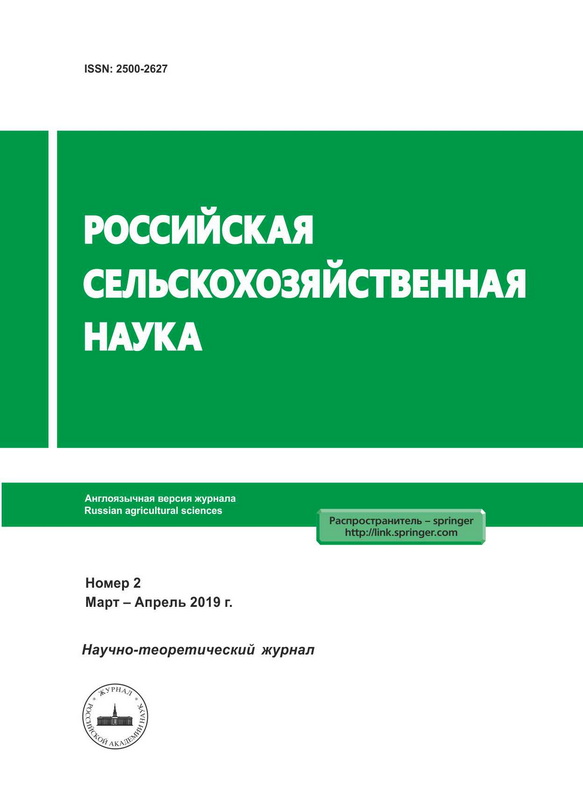Рост растений и продуктивность кукурузы в холодном климате*
- Авторы: Головко Т.К.1, Далькэ И.В.1, Шморгунов Г.Т.2, Триандафилов А.Ф.2, Тулинов А.Г.2
-
Учреждения:
- Институт биологии Коми научного центра УрО РАН
- Институт сельского хозяйства Коми научного центра УрО РАН
- Выпуск: № 2 (2019)
- Страницы: 19-23
- Раздел: Растениеводство
- URL: https://journals.eco-vector.com/2500-2627/article/view/15546
- DOI: https://doi.org/10.31857/S2500-26272019219-23
- ID: 15546
Цитировать
Полный текст
Аннотация
В условиях сравнительно прохладного и влажного сезона вегетации в центральном агроклиматическом районе Республики Коми кукуруза не уступает по интенсивности роста и фотосинтетической активности традиционно возделываемым в условиях северного Нечерноземья культурам. Цель исследований – изучить возможность и перспективность выращивания раннеспелых гибридов кукурузы в почвенно-климатических условиях Республики Коми. Полевой опыт заложен на базе Института сельского хозяйства Коми научного центра Уральского отделения Российской академии наук в 2016-2017 гг. на площади 1,6 га. В 2016 г. изучено 6 сортообразцов кукурузы, а в 2017 г. – дополнительно еще 15. Таким образом, из 21 сортов и гибридов были отобраны 7 сортообразцов для дальнейшего изучения. Представлены результаты предварительного исследования экологического испытания раннеспелых гибридов кукурузы при возделывании в агроклиматических условиях Республики Коми. Рассмотрены особенности их роста и развития, формирование урожая зеленой массы. Среди изучаемых сортов выделен Уральский 150 с лучшими кормовыми характеристиками. Его растения формировали 11-12 листьев с удельной поверхностной плотностью 0,30 г/дм2, листовой индекс ценоза составил 4 м2/м, максимальная скорость фотосинтеза листьев среднего яруса достигала 17 мкмоль СО /м2с. Средняя за два года урожайность зеленой массы изучаемых сортообразцов и гибридов кукурузы 2 составляла 380 ц/га. Содержание сухого вещества в биомассе не превышало 20%, содержание сырого протеина достигало 12%, клетчатки– 29%.
Ключевые слова
Об авторах
Т. К. Головко
Институт биологии Коми научного центра УрО РАН
Автор, ответственный за переписку.
Email: toolalgen@mail.ru
доктор биологических наук
Россия, СыктывкарИ. В. Далькэ
Институт биологии Коми научного центра УрО РАН
Email: golovko@ib.komisc.ru
кандидат биологических наук
Россия, СыктывкарГ. Т. Шморгунов
Институт сельского хозяйства Коми научного центра УрО РАН
Email: toolalgen@mail.ru
кандидат сельскохозяйственных наук
Россия, СыктывкарА. Ф, Триандафилов
Институт сельского хозяйства Коми научного центра УрО РАН
Email: toolalgen@mail.ru
кандидат технических наук
Россия, СыктывкарА. Г. Тулинов
Институт сельского хозяйства Коми научного центра УрО РАН
Email: toolalgen@mail.ru
кандидат сельскохозяйственных наук
Россия, СыктывкарСписок литературы
- Эдвардс Дж., Уокер Д. Фотосинтез С3 и С4 растений: механизмы и регуляция. – М.: Мир, 1986. – 598 с.
- Вавилов П.П., Болотова Е.С. Некоторые особенности роста и развития кукурузы в северных районах ее возделывания // Тр. Коми филиала АН СССР. – 1961. – №11. – С.57-69.
- Агроклиматические ресурсы Коми АССР . – Спб. : Гидрометеоиздат, 1973. – 136 с.
- Кайбеяйнен Э.Л. Параметры световой кривой фотосинтеза у Salix dasyclados и их изменение в ходе вегетации // Физиология растений. – 2009. – Т. 56. – № 4. – С. 490-499.
- Бельченко С.А., Белоус И.Н. Оценка влияния агротехники возделывания кукурузы на качество зеленой массы и силоса в условиях юго-западной части Нечерноземья // Вестник Курской ГСХА. – 2014. – №6. – С.49-52. Российская сельскохозяйственная наука, 2019, № 2
- Дуборезов В.М., Виноградов В.Н., Какоткин Е.М., Дуборезова М.Е. Продуктивность различных сортов кукурузы при возделывании на силос // Достижения науки и техники АПК. – 2012. – №8. – С.27-28.
- Надточаев М.Ф., Мелештвич М.А. Возделывание кукурузы на зерно и силос. 2013. URL: http://agrosbornik.ru/sovremennye-resursosberegayushhie-texnologii/1140-vozdelyvanie-kukuruzy-na-zerno-i-silos.html.
- Троц В.Б. Фотосинтез и продуктивность одновидовых и бинарных посевов силосных культур // Известия ТСХА. – 2010. – Вып.3. – С.123-126.
- Видович И.В. Формирование урожая кукурузы // Формирование урожая основных сельскохозяйственных культур. – М.: Колос, 1984. – С.175-195.
- Тооминг Х.Г. Экологические принципы максимальной продуктивности посевов. – Л.: Гидрометеоиздат, 1984. – 264 с.
- Головко Т.К., Родина Н.А., Куренкова С.В., Табаленкова Г.Н. Ячмень на Севере (селекционно-генетические и физиолого-биохимические основы продуктивности). – Екатеринбург: УрО РАН, 2004. – 155 с.
- Швецова В.М. Фотосинтез и продуктивность сельскохозяйственных растений на Севере. – Л.: Наука, 1987. – 95 с.
- Елисеев С.Л., Елисеев А.С. Вызревание зерна кукурузы в северных районах кукурузосеяния // Пермский аграрный вестник. – 2015. – №1 (9). – С.11-18.
- Родиков С.А. Отклонение суммы активных температур от среднего многолетнего значения как оценка климатических условий вегетационного периода яблони // Российская сельскохозяйственная наука. – 2016. – №1. – С.15-17.
- Ahmad L., Habib Kanth R., Parvaze S., Sheraz Mahdi S. Growing Degree Days to Forecast Crop Stages. In: Experimental Agrometeorology: A Practical Manual. Springer, Cham. 2017. URL: https://doi.org/10.1007/ 978-3-319-69185-5_14.
- Lauer J. Selecting Corn Silage Hybrids. 2011. URL: http://corn.agronomy.wisc.edu/AA/pdfs/A089.pdf.
- Miller P., Lanier W., Brandt S. Using Growing Degree Days to Predict Plant Stages. 2001. URL: http://corn.agronomy.wisc.edu/AA/pdfs/A089.pdf.
- Амелин А.В., Петрова С.Н. Особенности изменений климата на территории Орловской области за последние 100 лет и их влияние на развитие растениеводства в регионе // Вестник ОрелГАУ. – 2006. – №2-3. – С.75-78.
- Корнышев Д.С. Тенденции изменения температурного режима территории и стратегии сельскохозяйственного производства // Известия Великолукской ГСХА. – 2015. №2. – С. 8-14.
- Доклад об особенностях климата на территории Российской Федерации за 2016 год. – М., 2017. – 70 с.
Дополнительные файлы









